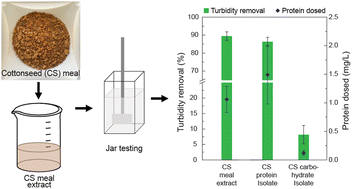Cottonseed extract as a coagulant for water treatment†
Abstract
Coagulation is an important unit process of water treatment to decrease suspended and dissolved contaminants. However, the use of chemical coagulants, such as alum and ferric chloride, contributes to growing health concerns regarding aluminum exposure and sustainability concerns due to high sludge volumes. Bio-coagulants represent low-cost, sustainable alternatives to chemical coagulants. In this work, cottonseed meal extract, with an average protein content of 77.0 ± 13.5 μg mL−1, was investigated for its coagulation effectiveness and was shown to decrease turbidity by 90%, regardless of initial turbidity (62.5–717 NTU) and the age of extract (2–218 days). Varying doses of cottonseed meal extract protein (0.77–3.83 mg L−1) on turbidity removal were also investigated. The cottonseed meal extract was separated into carbohydrate and protein fractions to determine the active component and it was found that the protein fraction was primarily responsible for coagulation activity. The protein extract was further analyzed to investigate the proteins present in the cottonseed meal extract to identify several proteins including legumin and vicilin. This work details an effective bio-coagulant, cottonseed meal extract, which can achieve high turbidity removal due to its protein components.



 Please wait while we load your content...
Please wait while we load your content...